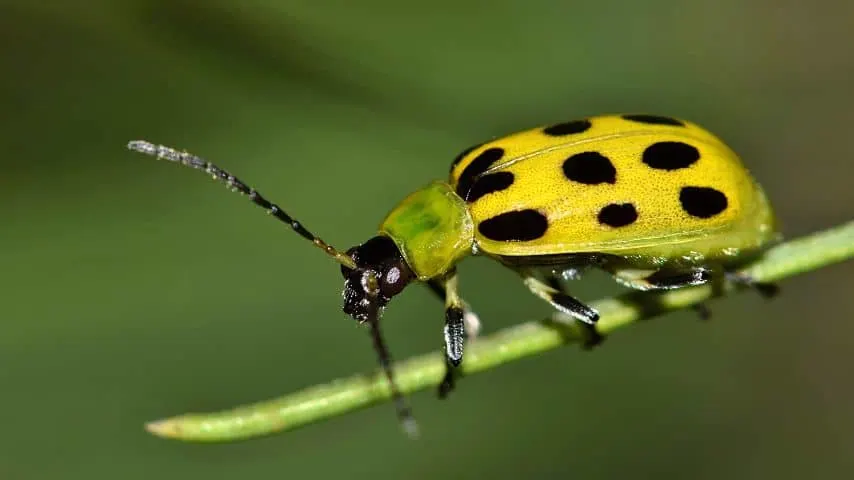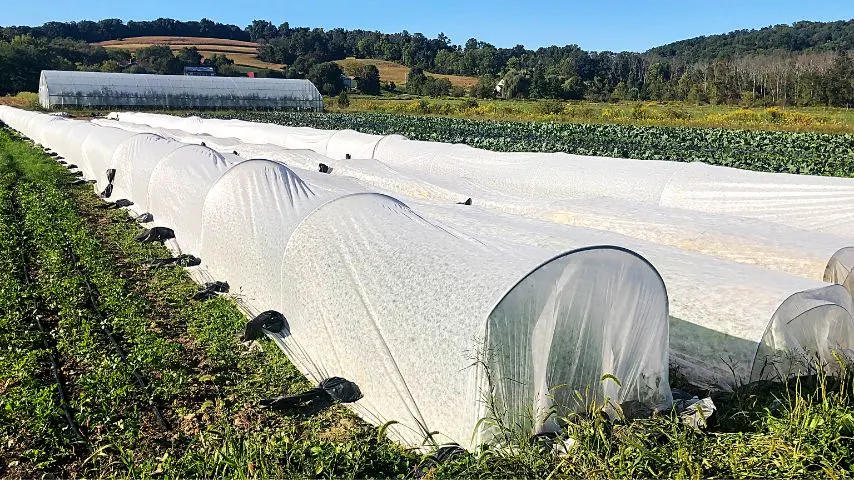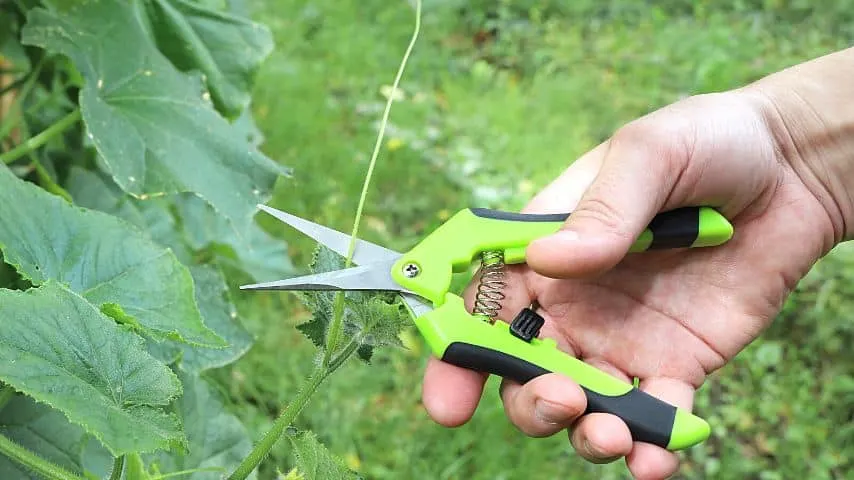A few days ago, I headed out into my garden to pick the main ingredient (my cucumbers) and found that my poor cucumber leaves were turning brown.
I was sure I had done everything to keep my plants in tip-top shape. But it turned out I didn’t.
Based on my experience with plants there are 5 reasons why cucumber leaves turn brown.
Table of Contents
Cucumber Leaves Are Turning Brown
Cucumber leaves are turning brown due to the soil lacking the nutrients it needs. Pests in the vines and a fungal disease may be spreading to all the leaves on the vines. Lastly, weather conditions such as heat and humidity can also cause the cucumber’s leaves to wilt and go brown.

5 Reasons Cucumber Leaves Are Turning Brown (+ How to Remedy It)
Reason 1: Poor Soil Conditions
One of the primary reasons your cucumber leaves turn brown is poor soil conditions.

If your cucumbers have been planted in soil that isn’t sterile (undergone heat or chemical process to kill pathogens in the soil), they’ll likely be infected with a disease.
The soil may also lack nutrients, which leaves your cucumbers vulnerable to diseases and weeds.
Signs of a cucumber growing in poor soil conditions:
- Roots are waterlogged as the water doesn’t drain well
- Brown, discolored leaves
- Stem rot
- Soft leaves
How to Remedy Poor Soil Conditions Affecting Your Cucumber Leaves
If the soil isn’t sterilized and your cucumber leaves are turning brown, you need to cut the infected leaves off the plant and burn them.
Unfortunately, nothing can cure the leaves once they have changed color.
Removing the infected cucumbers and foliage will prevent the spread of other diseases in the soil. For future reference, plant your cucumbers in sterile soil, such as potting soil.
Cucumbers thrive in well-draining, slightly acidic soil. To add more organic matter, you can work some mulch and sulfur into the soil. This will produce healthier and happier cucumber plants.

Reason 2: Pests in the Vines
A common pest that causes endless aggravation for gardeners is the cucumber beetle. These beetles are easily identified with their yellow and black striped abdomen, dark-colored head, and black antenna.

These nasty beetles feed on every part of the cucumber plant and cause the plant to wilt and the leaves to go brown.
This striped beetle also spreads unpleasant diseases such as bacterial wilt or mosaic virus from one plant to another. The disease starts with a few vines and spreads to the entirety of the plant quickly.
Signs of a cucumber plant being infested with pests are:
- Chewed off stems
- Wilting and brown leaves
- Holes appearing on leaves
How to Remedy Pests in Vines of Your Cucumber Leaves
There is no treatment or cure for cucumbers infected with bacterial wilt. Prevention is key.
Eradicate the cucumber beetles by using insecticides on the vines to help prevent the spreading of the disease further.
Top Tip: You can also cover your cucumbers with floating row covers to stop the beetles from gaining access to the vines, but you’ll need to remove these covers to allow pollination.

Reason 3: Gummy Stem Blight (Black Rot)
Cucumber plants are very susceptible to fungal diseases. Gummy stem blight (black rot) is a fungal disease that is commonly caused by the Didymella bryoniae fungus.
The fungus starts by turning your cucumber plant leaves brown.
This fungus wreaks havoc in gardens and greenhouses by killing off part of your plant or the whole plant. The fungus spreads to your entire crop if you leave it untreated.
Signs of a cucumber plant being infected with black rot:
- The leaves on the vines are brown
- Splitting stems
- Brown secretions oozing from the “wounds” on the stems
How to Remedy Gummy Stem Blight on Your Cucumber Leaves
Because this fungal disease spreads so quickly, it’s likely to kill off your cucumber plant before it can be saved.
The most effective way to prevent gummy stem blight is to rotate your cucumber crops and practice good sanitation.
Ensure that you’ve removed all dead plant material from your greenhouse or garden. Avoid planting your cucumbers in the same area every year.
If these preventative measures are unsuccessful, you can apply fungicides to the vines of your plant.
Reason 4: Aphids
Aphids are probably one of the worst pests to attack your cucumber plants. Aphids love cucumbers, and they are usually gathered under the vine’s leaves, sucking on the sap of the leaves.

Aphids like to gather in numbers, and your cucumber leaves go from green to yellow to brown and eventually die off completely.
You’ll notice your plant’s growth is stunted, and the cucumbers that it produces are deformed.
Signs of a cucumber plant being infested with aphids:
- Curled yellow and brown leaves
- Weak vines
- Stunted growth
- Small white flakes on the cucumber’s leaves
How to Remedy Aphids on Your Cucumber Leaves
It’s relatively easy to control and prevent aphid infestations. Check for signs of aphids underneath the leaves daily.
If you find aphids, you can scrape them off with your fingers into a bucket of soapy water.
Row covers help keep the pests off your cucumbers. Weed your garden regularly as aphids like to lay their eggs in weeds, particularly wild mustard or sow thistle.
Introducing ladybugs (natural predators) to your garden will help eradicate the aphids.

Top Tip: Neem oil is an excellent option for a natural pesticide and repellent. It contains a chemical called azadirachtin, which stops aphids from feeding.
It disrupts their hormones, and they aren’t able to grow or lay eggs.
Reason 5: Weather Conditions
Weather conditions play an essential role in the state of your cucumber plants.
Angular leaf spot is a common disease that thrives and spreads in hot, humid, and wet weather. The bacterium Pseudomonas syringae Lachrymans causes this disease.
If this disease is left untreated, it can cause your cucumbers to rot and the leaves to wither and die off.
Signs of cucumber plants being affected by weather conditions:
- Gray to brown discoloration on leaves
- Spots that expand as the disease progresses
- Tile-like pattern on leaves
How to Remedy Weather Conditions Affecting Your Cucumber Leaves
Angular leaf spot finds its way to your garden through carrier insects, infected seeds, and water.
If your plants have this disease, you will need to prune the affected leaves and use hot water treatment to try and remove some bacteria from any infected seeds (soak the seeds in hot water).

Try planting disease-resistant types of cucumbers, and don’t handle your plants during wet and humid weather conditions. This will prevent further disease spread.
Frequently Asked Questions about Cucumber Leaves Turning Brown
How do overwatered cucumbers look like?
An overwatered cucumber will have wilted yellow and brown leaves. The leaves will need to be removed as they will stunt the rest of the plant’s growth. Once the leaves are removed, the plant can promote new growth.
How do you rejuvenate cucumbers?
Rejuvenate cucumbers by watering the plants correctly, providing good fertilizer, and adding mulch to the topsoil. This will prevent evaporation and retain good soil moisture.
Conclusion On Cucumber Leaves Are Turning Brown
Cucumber leaves are turning brown because of the heat and because of insufficient humidity. Other reasons why the leaves are turning brown are pest infestations such as aphids and fungal diseases on the leaves.

Daniel has been a plant enthusiast for over 20 years. He owns hundreds of houseplants and prepares for the chili growing seasons yearly with great anticipation. His favorite plants are plant species in the Araceae family, such as Monstera, Philodendron, and Anthurium. He also loves gardening and is growing hot peppers, tomatoes, and many more vegetables.


